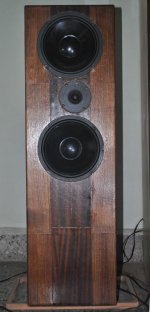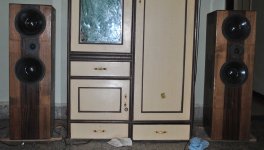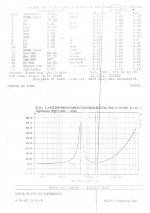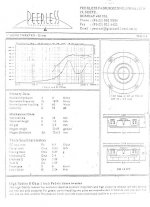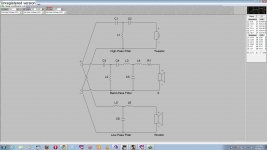Hello Friends.
I have made MDF box for my 3 way speakers Box Volume 58 Liters. Nothing added for damping . Kindly guide if this the proper volume.
I am facing a certain problem while playing these speakers. When playing Music If I am front of the speakers 7 to 8 ft from speakers. it sounds very punchy and tight, But seems to miss the depth. But if I go to corner of the room or across the speakers, there is good deep bass with the punch and tightness. Earlier I made down firing port , then Changed to rear firing port tube dimensions 3" wide and 6" deep
I have a custom made crossover made by a friend. But I want to make a crossover properly.
Please guide and help
I have made MDF box for my 3 way speakers Box Volume 58 Liters. Nothing added for damping . Kindly guide if this the proper volume.
I am facing a certain problem while playing these speakers. When playing Music If I am front of the speakers 7 to 8 ft from speakers. it sounds very punchy and tight, But seems to miss the depth. But if I go to corner of the room or across the speakers, there is good deep bass with the punch and tightness. Earlier I made down firing port , then Changed to rear firing port tube dimensions 3" wide and 6" deep
I have a custom made crossover made by a friend. But I want to make a crossover properly.
Please guide and help
Attachments
Last edited:
Nothing added for damping .
Strange ,very strange .
Or you did mean stuffing
Maybe , it was better to keep the port firing downwards ,as there were no cabinet walls in the vicinity of the inner duct port .
Then , it would have allowed to make some 'fine tuning' by changing the height from the floor 8
(1-3 inches).
I agree with ocih. It seems you need to know a little about the effect of room and wall reflection to bass reinforcement. If the port is on the back, 0.5m from wall is good (optimize between bass boominess and space availability).
Picowallspeaker,
Are you sure 1-3 inches is fine. This is not subwoofer. The F3 will not lower than 40Hz in my prediction.
Stuffing and bracing the box is surely better.
You can reduce the port length. It is good if you have 3 ports. One port 6", one port 5", one port 4". If you prefer 4" to 5", cut the 5" to 3.5". If you prefer the 4" to 3.5", cut the 6" to 4" and throw away the 3.5"
If you seal the box, the bass response will roll off sooner, but more gradually so you will have the impression of deep bass. And you will get good transient and controlled bass. It depends on your taste.
Picowallspeaker,
Are you sure 1-3 inches is fine. This is not subwoofer. The F3 will not lower than 40Hz in my prediction.
Stuffing and bracing the box is surely better.
You can reduce the port length. It is good if you have 3 ports. One port 6", one port 5", one port 4". If you prefer 4" to 5", cut the 5" to 3.5". If you prefer the 4" to 3.5", cut the 6" to 4" and throw away the 3.5"
If you seal the box, the bass response will roll off sooner, but more gradually so you will have the impression of deep bass. And you will get good transient and controlled bass. It depends on your taste.
Stuffing 'makes see' a larger box to the loudspeaker ,hence lowering Fb , in conjunction with the natural low-pass action of the port , putting it on the bottom and calculating it a little shorter allows also a minimum gain of bass frequencies ...
But stuffing a reflex box is the most important thing to do : just glue the 'sound absorber' onto the internal walls ,do not fill all the volume with it ,then increase if needed .
But stuffing a reflex box is the most important thing to do : just glue the 'sound absorber' onto the internal walls ,do not fill all the volume with it ,then increase if needed .
I suggest 'viki' to start new thread about crossover for his speakers here:
Multi-Way - diyAudio
Hello Mile,
I have started a thread in Multi way, and am getting replies.
As I have no experience in crossovers most of the replies I am not able to understand.
As we have been through amp building and with your guidance I have successfully made it. I am Amateur in crossovers, though it is troublesome for people to guide a novice with no experience what ever giving their important time.
I need to understand it right from basics. I have had problems in understanding theory, But I very well grasp Practicals, If I see a crossover being designed with few practical sessions I will learn it, Because thats become my habit.
Viki,
I told you that you will have to read one or two books on the subject. Those I mentioned are quite recommended.
Designing speakers is a complex matter and you will need to learn a bit. But there are some programs (like Bassbox) that make some calculations easier.
Here's a bunch of tools and program descriptions on speaker building and crossovers:
Steve Ekblad's Free Audio Software and On-Line Enclosure Design
You won't be able to understand crossovers, no matter how clever you are, unless you read a lot more.
I told you that you will have to read one or two books on the subject. Those I mentioned are quite recommended.
Designing speakers is a complex matter and you will need to learn a bit. But there are some programs (like Bassbox) that make some calculations easier.
Here's a bunch of tools and program descriptions on speaker building and crossovers:
Steve Ekblad's Free Audio Software and On-Line Enclosure Design
You won't be able to understand crossovers, no matter how clever you are, unless you read a lot more.
Viki,
I told you that you will have to read one or two books on the subject. Those I mentioned are quite recommended.
Designing speakers is a complex matter and you will need to learn a bit. But there are some programs (like Bassbox) that make some calculations easier.
Here's a bunch of tools and program descriptions on speaker building and crossovers:
Steve Ekblad's Free Audio Software and On-Line Enclosure Design
You won't be able to understand crossovers, no matter how clever you are, unless you read a lot more.
My friend has Xover pro, I tried modelling crossover in this software, and still Trying i will Post image of this, If possible guide.
Attachments
Last edited:
You do not seem to believe on what I'm telling you.
No one can guide you on crossover design if you do not learn how a speaker works and how you control it. You may look for theory information on the web, if you do not want to read a book, but there's no way you will avoid that.
A program is just a tool. If you do not know what it means what you are feeding into it, it will be pointless.
Sorry to be so blunt.
No one can guide you on crossover design if you do not learn how a speaker works and how you control it. You may look for theory information on the web, if you do not want to read a book, but there's no way you will avoid that.
A program is just a tool. If you do not know what it means what you are feeding into it, it will be pointless.
Sorry to be so blunt.
input the cut off frequenz
How to find the cut off frequency
Hello Friends.
I have made MDF box for my 3 way speakers Box Volume 58 Liters. Nothing added for damping . Kindly guide if this the proper volume.
I am facing a certain problem while playing these speakers. When playing Music If I am front of the speakers 7 to 8 ft from speakers. it sounds very punchy and tight, But seems to miss the depth. But if I go to corner of the room or across the speakers, there is good deep bass with the punch and tightness. Earlier I made down firing port , then Changed to rear firing port tube dimensions 3" wide and 6" deep
I have a custom made crossover made by a friend. But I want to make a crossover properly.
Please guide and help
ROOM is the answer to your questions. Until you find the same bass in front of the speakers as the one behind them the most probable reason is this!
Recently I "designed" bass reflex enclosures for a friend, he helped in the design too. We had all possible characteristics and parameters of the bass drivers measured. Then we entered the data in Bass Box 6 Pro. Then we hit the button "optimum". We even entered actual material thickness (30 mm MDF), and the wadding and stuffing, and actual front panel size in the program and actual reflex pipe diameter.
We even took into the accounts the volume displaced by drivers, crossover and bracing...
We even brought the schematics with values of the crossover together with all drivers to acoustics and electronic engineers to check and double check... they checked and double checked and gave green light...
Then we did EXACTLY what was prescribed by the program with great accuracy and care.
We used a known 800-4000 hz crossover and the same bass, midrange and treble drivers it was constructed for.
The end result were a healthy and heavy 128 L net internal volume, thick wall, braced three way bass reflexes which by all laws of nature should reproduce 30 hz @ - 6db.
My friend brought them at home, installed them, played some music through them and then he got into a state of mind which is best described as melancholic depression with suicidal deviation.
No bass!


There was no bass coming out of his bloody speakers! Great midrange and treble, briliant soundstage, detail, you call it they have it... Bass - NO, not at all!
I went to his place thinking that he is either deaf or nuts not to hear bass from a 12 inch driver that has under 30 hz resonance in almost 130 L tuned to ~30hz...
Well, there was no bass indeed! I almost died out of shame! After all I got him into all the trouble in first place... and believe me this was his first technical DIY anything in life! And it took him about two weeks half to full working day to complete the bloody bass lacking speakers and almost divorced...
After some inspections and investigation I found out that there actually was bass coming out of the speakers. Only it was nowhere to be found in the ordinary places to seek bass!
It was behind the speakers and on angles greater than ~60 degrees from one certain cross section of the room.
Tragically the only possible location for the speakers was facing in parallel with this particular cross section.
His living room has irregular shape in the bad acoustical meaning of the word.
Then we brought the speakers to my listening room
We brought the speakers to the place of another friend who's room is known to be good or at least neutral - again great sounding speakers...
Now my friend has a pair of 5 inch 2 way speakers and a sub in his living room and is uberly happy... Thankfully he didn't have to throw the speakers we made into the fireplace, they will be the first acoustic weapon of his coffee shop that is soon to open
So a nasty room can get you in some real adventures...
By the way check the woofer polarity, but I doubt it is it. And not only check it, but try with reverse polarity. - again I doubt it would help.
See the main characters of this story in post 11 and 12 here: http://www.diyaudio.com/forums/multi-way/179055-sealed-volume-2x12-tb-2.html
Wish you luck! And don't hurry to open yourself undue work!
- Status
- This old topic is closed. If you want to reopen this topic, contact a moderator using the "Report Post" button.
- Home
- Loudspeakers
- Multi-Way
- Help with box designing.
